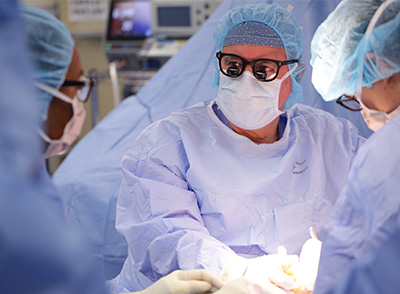Hand, Elbow, & Microvascular Surgery
The Hand, Elbow, and Microvascular Surgery Service continues to build on its rich legacy of achievements since its establishment more than 60 years ago. Our team of highly experienced orthopedic surgeons manages the full range of conditions affecting the hand and upper extremity, including the most challenging and complex trauma injuries.
Among the service’s pioneering achievements is an approach to stabilizing wrist ligament injuries — the RASL procedure (reduction and association of the scaphoid and lunate). Developed by Melvin P. Rosenwasser, MD, Chief of the Hand, Elbow, and Microvascular Surgery Service, it has become one of the recognized treatments around the world for chronic wrist instability, a common and disabling condition that leads to advanced osteoarthritis at an early age.

Dr. Melvin P. Rosenwasser
Device Development
Current treatments for osteoarthritis of the thumb may relieve pain but fail to restore full function and strength for patients. These historical procedures include trapezial resection arthroplasty with or without interposition or ligament reconstruction. However, no durable anatomic joint arthroplasty has yet been realized.
Collaborating with bioengineers in the Department of Bioengineering of Columbia University and the Columbia Biomedical Technology Accelerator, our surgeons have developed a novel allograft arthroplasty, which resurfaces the trapezial cartilage with an anatomically contoured saddle joint. This is made from fresh living human articular cartilage, which can resurface and restore the destroyed basal thumb joints. It is a true arthroplasty that can mimic the natural but complex thumb motions of pinch and grasp while maintaining a stable platform of contact as opposed to the void created by traditional resection arthroplasty.
The Cartibend™ allograft, which is harvested from the femoral trochlear groove, has demonstrated in a cadaver model that it can resurface the trapezium with an anatomically accurate articular surface that mimics thumb kinematics in pinch and grasp. The device is now being extended to clinical application in a randomized clinical trial to investigate the use of an osteochondral allograft in the surgical intervention phase of treatment for patients with basal joint arthritis.
The Columbia researchers are also collaborating on the development of a device to repair flexor tendons without suture. This novel implant, a stapling device, would allow tendons to be moved quickly after repair as opposed to the current treatment of carefully protecting repaired tendons after surgery.
Botulinum Toxin for Elbow Contracture
Elbow contracture following surgery or trauma is a common and often frustrating condition for patients. The Columbia physicians conceived the use of an intraoperative injection of botulinum toxin-A into the elbow flexors that foster muscle spasm and lead to a loss of elbow extension. The early phase of healing following surgery or trauma is when most joint stiffening takes place, which can be permanent if not treated by early mobilization. The physicians reason that if the early impediment to elbow motion secondary to pain-mediated muscle spasticity could be modified or eliminated, then tissue changes in the elbow capsule may be prevented and the mobility of the elbow greatly enhanced. The latest results of this clinical study will be presented at the American Shoulder and Elbow Surgeons Specialty Day Meeting in March 2019.



